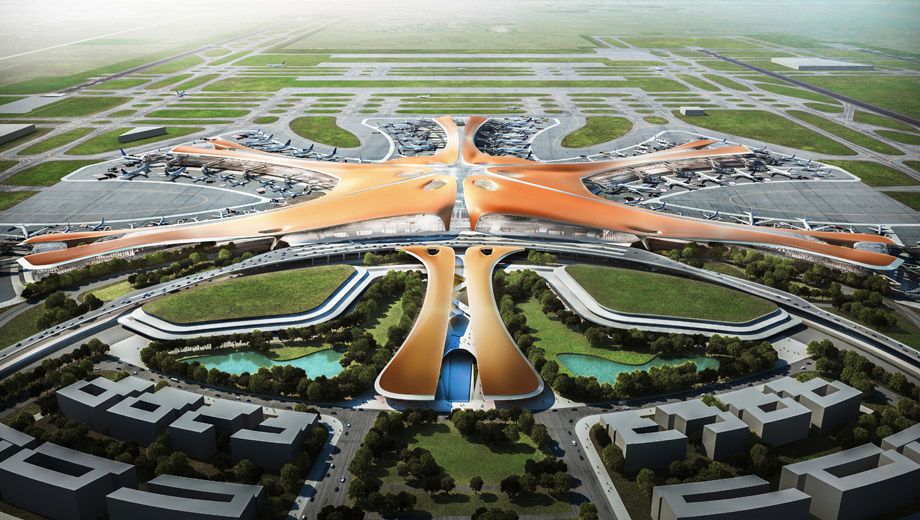Beijing's new mega-airport will shake up Chinese airline market

Like ancient warlords, China's three biggest airlines have dominated their regional cities: Air China controlling Beijing, China Eastern holding sway in the financial center of Shanghai, and China Southern ruling the roost down in export gateway Guangzhou. Until now.
Rising on a plain south of Beijing is a mega airport that is about to change the balance, bringing all three head to head in the capital as it becomes the world's biggest aviation hub.
The new airport, due to open in 2019, has been designated by authorities as the hub for members of the SkyTeam alliance, a global group of airlines that includes China Eastern and China Southern. The two Chinese carriers will each be allowed to capture 40 percent of the airport's passengers, gaining coveted time slots to Europe and the U.S. in Air China’s backyard.
"This is an absolute game-changer for China Eastern and China Southern," said Corrine Png, chief executive officer of Crucial Perspective in Singapore. "Having all the SkyTeam alliance members under one roof will enable seamless flight connections."
Air China fights rivals at Beijing’s new airport
The invasion of Air China's regional rivals has repercussions beyond China. As well as dominating their home bases, the big three Chinese players have each carved out a position abroad.
Air China, through its Star Alliance ties with Lufthansa and United Airlines, commands many of the routes to Europe and North America. China Eastern is the biggest carrier to Japan and South Korea. And Qantas partner China Southern is strong in Australia and Southeast Asia.
With access to more slots in Beijing, China Southern and China Eastern would potentially get more access to lucrative North American routes while their SkyTeam partners would get better access to the Chinese capital.
In addition, China Southern, the nation's biggest airline, would be able to draw traffic from its Southeast Asian links to fly via Beijing to the U.S.
Until then, they have to fight for slots at the existing airport which is close to capacity.
Air China, part of Star Alliance, whose 28 members include United, Singapore Airlines and Lufthansa, controls 38 percent of the slots at Beijing Capital International Airport, which handled 94 million passengers in 2016 – close to the maximum of 96 million.
"There are demands to add hundreds of flights in Beijing every day that get refused because we’re running out of resources," said Liu Xuesong, general manager of Capital Airports, the operator of Beijing’s existing airport. "The city is capable of running dual hubs."
Beijing bets big on surging air travel
The new US$12.9 billion airport in the southern suburb of Daxing, which was approved in 2014, would accommodate up to 100 million passengers a year with as many as seven runways. Liu estimates that by 2025, the two Beijing airports would share 170 million passengers, including 25 million on international flights.
Beijing is joining a select list of major cities with two or even three international airports, including London, New York, Tokyo and Paris. Unlike in Beijing, though, those airports usually take complementary roles, such as one serving international or intercontinental routes and the other focusing on domestic or regional flights.
"So far in history we haven't seen any city or city clusters having two hubs of the same scale," said Ma Chongxian, vice president of Air China's parent company, China National Aviation, at a conference in Beijing in May.
That's because it's usually airlines, rather than the government, who choose which airport to fly to, said Steve Saxon, a Shanghai-based partner at McKinsey & Co.
"China is different," Saxon said. "The government has substantial influence over the three largest carriers," which will help Beijing build two connecting hubs where other cities have failed.
China Eastern looks to twin-hub success
China Southern has said it will deploy more than 200 aircraft at the new airport by 2020 - about a fifth of its planned fleet by that time.
China Eastern will have "a remarkable advantage" by being a hub carrier both in Shanghai and Beijing as the capital is better positioned geographically as a connecting point for Europe and North America, said Will Horton, a Hong Kong-based analyst at CAPA Centre for Aviation. China Eastern already accounts for 50 percent of the market for the top 10 international flights from the country's financial hub Shanghai.
The construction of the new Beijing airport isn't all bad news for Air China. Its airport is closer to downtown, about 25 minutes in smooth traffic to the main business district in the eastern part of the capital, or the same time by train.
Planned road and rail links from the new airport would also whisk travelers into Beijing in about half an hour, but to the southwest, a part of the city that's less convenient for most business executives, especially during the capital's notoriously congested peak traffic times.
"Air China is likely to win share on key business routes," said McKinsey’s Saxon, "similar to how British Airways benefits from the privileged position it has in the more convenient London Heathrow."
That could affect the lucrative Beijing-Shanghai route, where China Eastern commands nearly 60 percent of the market, according to data compiled by Huatai Securities.
Oneworld missing out, again
The division of Beijing's airports by alliance leaves out the third-biggest group, Oneworld. Members of the group, started in 1999 by Hong Kong-based Cathay Pacific and four other carriers, are instead relying on individual links with the Chinese airlines.
Oneworld member American Airlines announced in March a 2.7 percent stake purchase in China Southern for US$200 million, and will deploy some of its flights at the new Beijing airport as part of the deal. The U.S. carrier had to postpone the launch of a Los Angeles-to-Beijing flight earlier this year as it failed to secure a time slot.
Delta Air Lines, which has a 3.2 percent stake in China Eastern, should also earn more slots at the new airport.
A representative for Cathay didn't respond to an email seeking comments.
Chinese authorities have committed to preserving slots at the current and new airports for carriers that already fly to Beijing, Oneworld said in an e-mail. It said 10 Oneworld members serve the city with a total of 163 weekly flights from 16 international destinations.
Crowded skies ahead
One major effect of all the expansion will be some very congested skies over China, which has some of the most constricted airspace in the world because of priority for military planes.
CAPA estimates that only about 20 percent the airspace over China is open to civilian flights – one of the reasons for Chinese airlines' spotty on-time performance record.
"There is no point opening another massive airport without addressing the restricted airspace issue," Crucial Perspective's Png said.
One option is a trial in Guangzhou that allows military and civil aircraft to share some airspace.
The experiment led to a 7 percent increase in passenger numbers in the Pearl River Delta, said Che Jinjun, director general of the air traffic management bureau at the Civil Aviation Administration of China. The trial will be expanded to Beijing and Shanghai, CAAC administrator Feng Zhenglin said at a recent aviation forum in Beijing.
"The good news is that the government seems committed to airspace reform, which should open up enough space for the expansion," Saxon said. "It has to.





Qantas - Qantas Frequent Flyer
14 Feb 2017
Total posts 25
Exciting! Next up, world domination....
Asiana Airlines - Asiana Club
09 Feb 2017
Total posts 41
Hopefully they link it up to the high-speed rail network. The transfer at Shanghai Hongqiao is too convenient and virtually eliminates the demand for a sizeable chunk of short-haul domestic routes. Especially given the air traffic capacity restrictions ...
Air New Zealand - Airpoints
12 Feb 2016
Total posts 20
A connection to the new airport is planned as part of the Beijing - Tianjin - Hebei high speed rail network
25 Sep 2013
Total posts 1242
Kinda looks like F1 World in Abu Dhabi, no?
Qantas - Qantas Frequent Flyer
02 Jul 2011
Total posts 1374
One would hope that Qantas with its relationships with China Eastern (not mentioned in the article) and China Southern makes the move as well for QF107/108
Qantas - Qantas Frequent Flyer
17 Aug 2016
Total posts 23
So China can have a new airport built by 2019 but year we have to wait 10 years from the second sydney airport with only 1 runway
Qantas - Qantas Frequent Flyer
27 Mar 2015
Total posts 13
more like 50 years isn't it? and they still cant decide on badgerys creek - or start it. we are sooo backward
Qantas - Qantas Frequent Flyer
27 Mar 2015
Total posts 13
same with perth actually - equally as stunted in planning and thinking
Qantas - Qantas Frequent Flyer
02 Jul 2011
Total posts 1374
In the last 10yrs China has also built a High Speed Rail network that now accounts for 2/3rds of global HSR rail length.
26 Jun 2015
Total posts 5
Do not push for badgreeks creek. who is going to travel 1 hour or more to get to it from the city.
Qantas - Qantas Frequent Flyer
17 Aug 2016
Total posts 23
They make more money from parking! And there are heaps of domestic departures between the above mentioned times sydney airport does have s plan for another terminal where the qantas jet base is.
Asiana Airlines - Asiana Club
09 Feb 2017
Total posts 41
Or we could extend the parallel runway to handle longer flights on bigger aircraft, and increase capacity for international flights in domestic off-peak hours.
Hi Guest, join in the discussion on Beijing's new mega-airport will shake up Chinese airline market